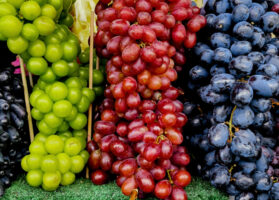Competition from Peru hurts Chilean grape exports to the U.S.
Overview of table grapes from Chile in the U.S. market, complemented by charts from Agronometrics. Original published on May 25, 2023.
Facing pressure from Peru in the U.S. market, Chilean grape exports to the U.S. market are projected to fall nearly 9% in the 2022-23 season.
In its semi-annual report on Chilean deciduous fruit, the USDA’s Foreign Agricultural Service estimates that total Chilean table grape exports will decrease by 8.7% in the 2022-23 season.
The USDA reported that 2022-23 Chilean table grape production will decrease by 8.6%, with output projected at 720,000 metric tons. Chilean grape exports in 2022-23 are forecast at 550,000 metric tons, down 8.7% from 2021-22.

Source: USDA Market News via Agronometrics.
(Agronometrics users can view this chart with live updates here)
The U.S. is the main market for Chilean table grape exports and accounted for 51% of Chilean table grape exports in 2021-22.
From September 2022 through March 2023, the USDA reported U.S. imports of Chilean grapes totaled 442,085 metric tons, down 10% from 490,603 metric tons during the same period the previous year.
The decline in projected exports is directly linked to the drop in production, the USDA report said.
“The decrease in production is caused by a decrease in table grape area planted and by adverse climatic conditions in the central part of the country which lowered yields,” the report said. “Table grape area planted is on a decreasing trend due to low profits and competition from Peruvian fruit in export markets.”
Chilean grape area decreased from 133,068 acres in the marketing year 2011-12 to 106,317 acres in the marketing year 2022-23, the report said. Data from Chile’s agricultural officials shows a decrease in area planted from all table grape production regions, the report said.
Competition from Peru in the U.S. market, high production costs (labor, transport and chemical products) and the need to update table grape varieties have put downward pressure on table grape exports, according to the report.
“Decreases in area planted are especially significant in the Atacama region which has few alternatives to table grape production. In the Coquimbo and Valparaíso regions, reduction in table grape area planted is offset by an increase in citrus area planted,” the report said.
Table grape area planted in the Metropolitana and O’Higgins region decreased by 14.1% and 52%, respectively, over the last three marketing years, the report said.
“In these regions, the area planted with table grapes was replaced by more profitable crops such as walnuts, cherries, and citrus, or by the expansion of the urban area,” the report said.
IMPROVEMENT SOUGHT
The Chilean grape industry is hoping to improve its export position for the U.S. market.
The Chilean grape industry is seeking a systems approach for pest control to improve market access to the U.S. for three Chilean growing regions: Atacama, Coquimbo and Valparaiso.
“A systems approach would benefit the three Chilean regions by avoiding the use of methyl bromide fumigation to mitigate against European grapevine moth,” the report said. “Fumigation decreases the quality and shelf life of the fruit, which results in lower prices from retailers. Further, fumigated product is ineligible to be certified USDA organic.”
The USDA’s Animal and Plant Health Inspection Service published a proposed rule about the Chilean systems approach in the Federal Register in October. The comment period ended on Jan. 17 this year, but Chilean authorities and exporters are awaiting the publication of the final rule, the report said.
The News in Charts is a collection of stories from the industry complemented by charts from Agronometrics to help better tell their story.
Access the original article with this (Link)






